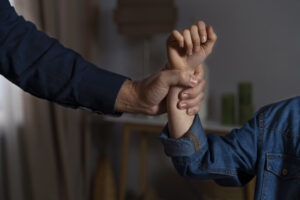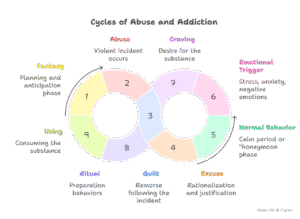In the quiet moments between crisis and clarity, when the weight of silence becomes unbearable, there’s a truth that too many people carry alone: the devastating intersection of substance abuse and domestic violence. It’s not just about statistics or clinical definitions—it’s about real lives, real pain, and the complex ways that addiction and abuse become tragically intertwined.
If you’re reading this, perhaps you’ve felt that weight yourself. Maybe you’ve wondered why someone you love becomes a different person when they drink. Or perhaps you’ve questioned your own behavior, recognizing patterns you can’t seem to break. At Forward Recovery, we’ve walked alongside countless individuals navigating this treacherous terrain, and we want you to know: understanding this connection is the first step toward breaking free.![]()
When Substances Become Weapons
The relationship between addiction and domestic violence isn’t linear—it’s a complex web where each thread pulls and strains against the other. Research from the World Health Organization reveals that intimate partner violence affects approximately one in three women worldwide, and when you layer substance use into this equation, the picture becomes even more disturbing [1]. But here’s what often goes unspoken: this isn’t just about perpetrators and victims. It’s about human beings trapped in cycles they never intended to create.

Think of it like this: substance abuse doesn’t cause domestic violence, but it’s the gasoline thrown on an already smoldering fire. Alcohol and drugs lower inhibitions, impair judgment, and intensify emotions that might otherwise remain controlled. A 2019 study published in the journal Substance Abuse Treatment, Prevention, and Policy found that alcohol is involved in approximately 55% of domestic violence incidents [2]. That’s more than half of all cases where someone’s safety is compromised, their dignity stripped away, and their sense of security shattered.
The Bidirectional Nature of Trauma
Here’s where the narrative gets complicated, and where compassion becomes crucial. Domestic violence and substance abuse create a bidirectional highway—each feeding into the other in ways that make escape feel impossible. According to the WHO’s fact sheet on intimate partner violence and alcohol consumption, women experiencing abuse are more likely to engage in harmful drinking as a coping mechanism [3]. Conversely, individuals struggling with addiction may become abusive as their substance use spirals out of control.
Consider Sarah’s story—a composite of many individuals we’ve treated at Forward Recovery. She started drinking socially, but as her partner’s verbal abuse intensified, wine became her nightly escape. The more she drank, the more volatile their arguments became. Soon, what started as emotional abuse escalated to physical violence. Was it the alcohol that caused the abuse? No. But did it create an environment where violence could flourish unchecked? Absolutely.
Research published in the International Journal of Environmental Research and Public Health demonstrates that substance use disorders and intimate partner violence share common risk factors, including childhood trauma, mental health issues, and socioeconomic stress [4]. This overlap isn’t coincidental—it’s a pattern we see repeatedly in treatment settings.
Recognizing the Signs
You might be wondering: how do I know if substance abuse and domestic violence are connected in my situation? The signs aren’t always obvious, especially when you’re living inside the storm.
Watch for these patterns:
- Increased aggression during or after substance use – Does your partner’s demeanor shift dramatically when they drink or use drugs? Do small disagreements escalate into threatening behavior?
- Using substances to cope with abuse – Have you found yourself reaching for alcohol or pills to numb the pain of emotional or physical violence?
- Isolation intensifying alongside substance use – Abusers often isolate their partners, and addiction compounds this isolation, creating a bubble where dangerous behaviors go unchallenged.
- Financial control and substance-related expenses – Is money being diverted to support a substance habit while basic needs go unmet? This economic abuse often accompanies both addiction and domestic violence.
- Promises of change that never materialize – The cycle of abuse and addiction both follow similar patterns: crisis, apology, brief improvement, then return to harmful behavior.

The Deadly Statistics You Need to Know
Let’s talk numbers, because sometimes data cuts through denial in ways that feelings cannot. According to research from the University of Pennsylvania’s Department of Criminology, alcohol regulation policies can significantly impact domestic violence rates—suggesting that when substance use decreases, violence often decreases too [5].
Consider these sobering facts about alcohol and domestic violence statistics:
- Alcohol is a factor in approximately 55% of domestic violence cases
- Women in relationships with heavy drinkers are 3.6 times more likely to be assaulted by their partners
- Children who grow up witnessing both addiction and abuse are 74% more likely to develop substance use disorders themselves
- Only 34% of domestic violence incidents are reported to police, and even fewer involve acknowledgment of substance abuse as a contributing factor
The connection between drugs and violence follows similar patterns. Stimulants like cocaine and methamphetamine are particularly associated with aggressive behavior and paranoia, creating dangerous situations that can erupt without warning.
Why Rehab Must Address Both Issues
Here’s something we’ve learned at Forward Recovery: you cannot successfully treat substance abuse without addressing the domestic violence that often accompanies it, and vice versa. This is where domestic violence rehab programs differ from standard addiction treatment—they recognize that these issues are inseparable for many individuals.
Traditional addiction treatment might help you stop drinking, but if you’re returning to an abusive environment, or if your own abusive behaviors stem from untreated trauma and addiction, sobriety alone won’t break the cycle. That’s why comprehensive treatment must include:
- Trauma-informed care that recognizes how abuse shapes addiction patterns
- Safety planning for those experiencing violence
- Anger management and behavioral therapy for those exhibiting violent behaviors
- Family therapy that addresses dysfunctional relationship dynamics
- Dual diagnosis treatment for co-occurring mental health conditions
The relationship between abuse and addiction runs deep, often rooted in unprocessed trauma, learned behaviors, and neurological changes caused by chronic substance use. When we address only one piece of this puzzle, we’re setting people up for relapse—both into substance use and into violent dynamics.
The Path Forward: Breaking Free from Both Chains
Recovery from the intertwined issues of substance use and domestic violence isn’t a straight line—it’s a winding path that requires courage, support, and specialized care. If you’re experiencing both substance abuse and violence in your life, here’s what the journey toward freedom might look like:
Immediate Safety First: Your physical safety is paramount. If you’re in immediate danger, contact the National Domestic Violence Hotline at 1-800-799-7233. They can help you create a safety plan that accounts for both the violence and any substance use issues.
Specialized Treatment: Look for programs like ours at Forward Recovery that understand the complex relationship between addiction and abuse. We offer:
- Individual therapy addressing trauma and addiction
- Group sessions with others who understand both struggles
- Medical detox in a safe, secure environment
- Continuing care that bridges the gap between treatment and independent living
Addressing Root Causes: Both alcoholism and domestic violence often stem from deeper issues—childhood trauma, untreated mental health conditions, learned behaviors from family of origin. Effective treatment digs into these foundations rather than just treating surface symptoms.
Building New Coping Mechanisms: If substances have been your way of managing the pain of abuse, you’ll need healthier alternatives. This might include mindfulness practices, exercise, creative expression, and building a support network of people who understand your journey.
FAQs – Frequently Asked Questions
Q: Does substance abuse cause domestic violence? A: Substance abuse doesn’t directly cause domestic violence, but it significantly increases risk and severity. Substances lower inhibitions and impair judgment, making violent behavior more likely in individuals already predisposed to aggression. Research shows that while not all people with substance use disorders become violent, the co-occurrence rate is alarmingly high—suggesting substances act as an accelerant rather than a root cause.
Q: Can someone recover from both addiction and abusive behavior simultaneously? A: Yes, but it requires specialized, integrated treatment. Recovery from substance use and family violence must address both issues concurrently. Many individuals successfully change their behavior through programs that combine addiction treatment, trauma therapy, anger management, and accountability measures. However, this requires genuine commitment and often intensive therapeutic intervention.
Q: If my partner stops drinking, will the abuse stop? A: Not necessarily. While reducing or eliminating substance use often decreases the frequency and intensity of violence, it doesn’t automatically resolve the underlying issues that drive abusive behavior. Many people continue abusive patterns even when sober. True change requires addressing the attitudes, beliefs, and behaviors that enable abuse, regardless of substance use.
Q: How do I know if I should leave or if treatment could help? A: Your safety is the primary consideration. If you’re experiencing physical violence, threats, or feel genuinely afraid, prioritizing your safety through separation is crucial. Treatment can be helpful, but it shouldn’t come at the cost of your wellbeing. Consider working with a domestic violence advocate who can help you assess risk and explore options that protect you while potentially opening doors to treatment for your partner.
Q: What’s the connection between sexual abuse and addiction? A: Survivors of sexual abuse have significantly higher rates of substance use disorders—often using drugs or alcohol to cope with trauma symptoms like anxiety, depression, and PTSD. Conversely, substance use increases vulnerability to sexual violence. Treatment must address both the trauma and the addiction, recognizing how deeply interconnected they are in survivors’ lives.
A Message of Hope
If there’s one thing we want you to take from this article, it’s this: the connection between substance abuse and violence might be strong, but it isn’t unbreakable. We’ve seen individuals transform their lives, leaving behind patterns they once thought were inevitable. We’ve watched families heal, relationships rebuild on foundations of mutual respect, and people discover versions of themselves they’d forgotten existed.
At Forward Recovery, we understand that reaching out feels terrifying. Admitting that addiction and abuse have become entangled in your life requires vulnerability that might feel impossible right now. But here’s what we know from years of experience: you don’t have to figure this out alone. Whether you’re struggling with addiction and abuse in your own life, witnessing it in someone you love, or trying to break free from patterns that no longer serve you, help is available.
Recovery isn’t about becoming perfect—it’s about becoming free. Free from the substances that cloud your judgment, free from the violence that steals your peace and free to build a life defined by choice rather than compulsion, by connection rather than fear.
The intersection of domestic violence and substance abuse creates a particularly painful kind of imprisonment, but the key to that cell exists. Sometimes it takes professional help to turn it. If you’re ready to explore what freedom might look like, we’re here to walk that path with you.
Sources:
[1] World Health Organization. (2021). Violence against women. WHO Fact Sheets. – https://www.who.int/news-room/fact-sheets/detail/violence-against-women
[2] McHugh, R. K., et al. (2019). Sex and gender differences in substance use disorders. Substance Abuse Treatment, Prevention, and Policy. – https://pmc.ncbi.nlm.nih.gov/articles/PMC6642831
[3] World Health Organization. (2014). Intimate partner violence and alcohol. WHO Fact Sheet. – https://womensaidorkney.org.uk/wp-content/uploads/2014/08/WHO-IPA-and-Alcohol-Fact-sheet.pdf
[4] Reingle Gonzalez, J. M., & Connell, N. M. (2024). Substance use and intimate partner violence: A comprehensive review. International Journal of Environmental Research and Public Health. – https://pmc.ncbi.nlm.nih.gov/articles/PMC11073422
[5] Owens, E. (2015). The effect of alcohol regulation on intimate partner violence. University of Pennsylvania Criminology Department. – https://crim.sas.upenn.edu/sites/default/files/2015-4.0_Owens_AlcoholRegulation(1).pdf






Leave a comment
You must be logged in to post a comment.